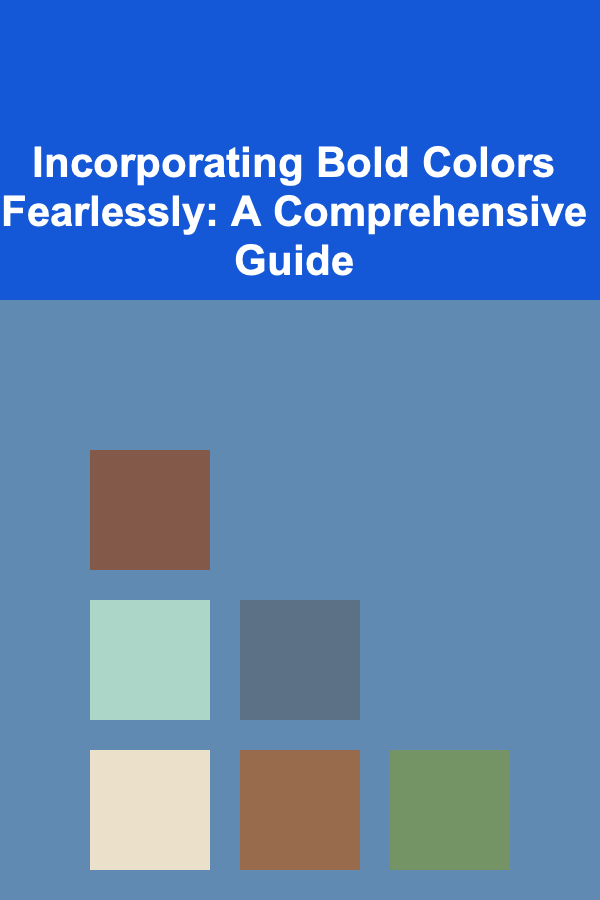
Incorporating Bold Colors Fearlessly: A Comprehensive Guide
ebook include PDF & Audio bundle (Micro Guide)
$12.99$5.99
Limited Time Offer! Order within the next:

Bold colors. They evoke feelings of excitement, energy, and individuality. But for many, the prospect of incorporating them into their lives, whether in their homes, wardrobes, or even their creative work, can be daunting. Fear of making a mistake, of creating a space that's overwhelming or clashing, often holds people back. This guide aims to dismantle those fears and provide a practical, thoughtful, and inspiring approach to embracing bold colors with confidence and style. We'll explore color theory, practical application techniques, and creative strategies to help you unleash the power of vibrant hues without hesitation.
Understanding the Psychology of Color
Before diving into application, it's crucial to understand the psychology behind color. Colors aren't just aesthetic choices; they have the power to influence our moods, behaviors, and perceptions. Consider these common associations:
- Red: Energy, passion, excitement, urgency. It can be stimulating but also overwhelming in large doses.
- Blue: Calmness, serenity, trust, stability. Often associated with professionalism and security.
- Yellow: Optimism, happiness, energy, creativity. Can be uplifting but also agitating if overused.
- Green: Nature, growth, harmony, health. A balancing and refreshing color.
- Orange: Enthusiasm, creativity, warmth, fun. A vibrant and inviting color.
- Purple: Luxury, creativity, wisdom, spirituality. Can be both calming and stimulating.
- Pink: Romance, tenderness, kindness, joy. A gentle and comforting color.
These associations are not universal, of course. Cultural differences and personal experiences play a significant role in how we perceive color. However, understanding these general tendencies can help you make informed decisions about which colors to use and how to use them effectively. For example, using red in a high-energy area like a gym might be appropriate, while using it in a bedroom might be disruptive to sleep.
Color Theory: Your Foundation for Success
Color theory is the cornerstone of successful color application. It provides a framework for understanding how colors interact and how to create harmonious and visually appealing combinations. Key concepts include:
The Color Wheel
The color wheel is a visual representation of colors arranged according to their chromatic relationships. It's an indispensable tool for understanding color harmonies.
Color Harmonies
Color harmonies are pleasing combinations of colors based on their relationships on the color wheel.
- Complementary Colors: Colors opposite each other on the color wheel (e.g., red and green, blue and orange, yellow and purple). They create high contrast and visual excitement. When used together, they can make each other appear more vibrant.
- Analogous Colors: Colors that are next to each other on the color wheel (e.g., blue, blue-green, and green). They create a harmonious and soothing effect. Think of nature's color palettes.
- Triadic Colors: Three colors that are equally spaced on the color wheel (e.g., red, yellow, and blue; orange, green, and purple). They create a vibrant and balanced scheme.
- Tetradic (or Double Complementary) Colors: Two pairs of complementary colors (e.g., red and green, plus blue and orange). This is the most complex scheme and requires careful balancing to avoid visual chaos.
- Monochromatic Colors: Variations of a single color (e.g., different shades, tints, and tones of blue). This creates a unified and sophisticated look.
Value, Saturation, and Hue
Understanding the three main properties of color is essential for creating nuanced and effective color schemes.
- Hue: The pure color, such as red, blue, or green.
- Value: The lightness or darkness of a color. Think of it as how much white or black is added to the hue.
- Saturation (or Chroma): The intensity or purity of a color. Highly saturated colors are vibrant and bold; less saturated colors are muted and subtle.
By manipulating value and saturation, you can create a wide range of effects with even the boldest colors. For example, a highly saturated bright yellow can be overwhelming, but a desaturated, muted yellow can be calming and sophisticated.
Practical Application: Bringing Bold Colors to Life
Now that we've covered the theory, let's explore practical strategies for incorporating bold colors into different aspects of your life.
In Your Home
Decorating with bold colors can transform a space from bland to breathtaking. Here's how to approach it:
- Start Small: Don't feel pressured to overhaul your entire home at once. Begin with a smaller space, like a powder room or entryway, to experiment and gain confidence. These spaces are less critical and allow for more risk-taking.
- Accent Walls: A single bold accent wall can add a dramatic pop of color without overwhelming the room. Choose a wall that's a natural focal point, such as the wall behind your bed or sofa. Consider the size of the room. A small room can handle a darker, more intense accent wall, while a larger room may benefit from a lighter, brighter shade.
- Furniture: A statement piece of furniture, such as a bright sofa or a boldly colored armchair, can be a fantastic way to introduce color. Consider upholstery fabrics carefully. Velvet adds richness and depth to bold colors, while linen offers a more casual and textural appeal.
- Accessories: Pillows, throws, rugs, artwork, and decorative objects are an easy and affordable way to incorporate bold colors. You can easily swap them out as your tastes change or the seasons shift. Group accessories together to create a cohesive color story.
- The 60-30-10 Rule: This is a classic design guideline that helps create balanced and harmonious color schemes. 60% of the room should be the dominant color (usually a neutral), 30% should be a secondary color (often a bolder hue), and 10% should be an accent color (the boldest pop).
- Consider the Lighting: Natural and artificial lighting can significantly impact how colors appear. Test paint samples in different lighting conditions before committing to a color.
- Use Neutral Backdrops: Bold colors often look best when paired with neutral backgrounds like white, gray, beige, or even black. These neutrals provide a calming counterbalance and allow the bold colors to shine.
In Your Wardrobe
Adding bold colors to your wardrobe can elevate your style and express your personality. Here's how to do it fearlessly:
- Start with Accessories: If you're hesitant to wear a brightly colored dress, start with smaller accessories like scarves, handbags, shoes, or jewelry. These can add a pop of color to a neutral outfit without feeling overwhelming.
- Color Blocking: Combine different bold colors in your outfit to create a striking and modern look. Use the color wheel as a guide to choose complementary or analogous colors.
- Monochromatic Outfits: Wearing different shades of the same color can create a chic and sophisticated look. Experiment with texture and layering to add depth and interest.
- Understand Your Skin Tone: Certain colors complement different skin tones better than others. Generally, warm skin tones (with yellow or golden undertones) look great in warm colors like red, orange, and yellow, while cool skin tones (with pink or blue undertones) look great in cool colors like blue, green, and purple. However, this is just a guideline, and the best way to find out what works for you is to experiment.
- Consider the Occasion: The appropriateness of bold colors depends on the occasion. A bright red dress might be perfect for a party but less suitable for a formal business meeting.
- Confidence is Key: The most important thing when wearing bold colors is to wear them with confidence. If you feel good in what you're wearing, you'll radiate confidence and pull off the look effortlessly.
- Balance Bold with Neutral: A bright top can be paired with neutral bottoms (like black pants or a beige skirt), or vice-versa. This helps ground the outfit and prevents it from being too overwhelming.
In Your Creative Work
Whether you're a painter, graphic designer, photographer, or any other type of artist, bold colors can be a powerful tool for expressing your vision. Here's how to use them effectively:
- Create a Mood Board: Before you start working on your project, create a mood board with images, colors, and textures that inspire you. This will help you develop a cohesive color palette.
- Experiment with Different Combinations: Don't be afraid to experiment with different color combinations and see what works best. Use online color palette generators or physical color swatches to explore different options.
- Use Color to Create Emphasis: Use bold colors to draw attention to specific elements in your design or artwork. A single bright color can be used to highlight a focal point and create visual interest.
- Consider the Context: The meaning and impact of a color can change depending on the context in which it's used. Think about the overall message you want to convey and choose colors that support that message.
- Balance Bold with Subtlety: Not every element in your design or artwork needs to be bold. Use subtle colors and neutral tones to balance the bolder colors and create a sense of harmony.
- Embrace Negative Space: Negative space (or white space) is the empty space around and between elements in a design. It can be a powerful tool for creating visual balance and highlighting the bold colors.
- Digital Tools: Utilize digital tools like Adobe Color or Coolors to generate color palettes and explore different color harmonies. These tools can help you visualize how colors will interact and refine your choices.
Overcoming the Fear: Tips and Tricks
The biggest hurdle to incorporating bold colors is often fear. Here are some tips to help you overcome that fear and embrace the power of color:
- Start Small and Experiment: As mentioned earlier, start with small doses of color and gradually increase the intensity as you become more comfortable. Experiment with different shades and combinations to find what you love.
- Seek Inspiration: Look for inspiration in magazines, websites, social media, and even nature. Pay attention to how designers and artists use bold colors effectively.
- Don't Be Afraid to Make Mistakes: Everyone makes mistakes, and that's okay. If you don't like a particular color combination, you can always change it. Think of it as a learning process.
- Trust Your Instincts: Ultimately, the best way to choose colors is to trust your instincts. If a color makes you feel good, chances are you'll love it in your home, wardrobe, or artwork.
- Get a Second Opinion: If you're unsure about a particular color choice, ask a friend, designer, or stylist for their opinion. A fresh perspective can be incredibly helpful.
- Remember the Power of Paint: Paint is one of the most affordable and transformative tools in interior design. Don't be afraid to experiment with bold paint colors. If you don't like it, you can always repaint!
- Focus on the Positive: Instead of focusing on what could go wrong, focus on the positive aspects of incorporating bold colors. Think about the energy, excitement, and personality that bold colors can bring to your life.
- Consider Cultural Influences: Explore different cultures and their use of color. This can broaden your perspective and inspire you to try new and unexpected combinations.
Bold Color Combinations to Inspire You
To further ignite your creative spark, here are some bold color combinations that have proven to be successful across various applications:
- Teal and Coral: A vibrant and refreshing combination that evokes tropical vibes. Perfect for beach-themed decor or summer wardrobes.
- Mustard Yellow and Navy Blue: A sophisticated and timeless combination that balances warmth and coolness. Ideal for classic interiors or preppy outfits.
- Emerald Green and Fuchsia Pink: A bold and luxurious combination that exudes confidence and glamour. Perfect for statement jewelry or high-end interiors.
- Turquoise and Tangerine: An energetic and playful combination that radiates positivity. Great for children's rooms or creative workspaces.
- Purple and Gold: A regal and opulent combination that symbolizes wealth and power. Ideal for formal events or luxurious interiors.
- Black and Red: A classic and dramatic combination that commands attention. Suitable for edgy fashion styles or striking graphic designs.
These are just a few examples, and the possibilities are endless. Don't be afraid to experiment and discover your own unique color combinations.
Maintaining the Bold: Keeping it Fresh
Once you've embraced bold colors, the key is to maintain their vibrancy and prevent them from becoming stale or overwhelming. Here's how:
- Regularly Assess and Re-evaluate: Periodically take a step back and assess your color choices. Are they still working for you? Do they still reflect your personality and style?
- Seasonal Updates: Consider making seasonal updates to your color palette. Switch out accessories, artwork, or even furniture to reflect the changing seasons.
- Introduce New Textures and Patterns: Adding new textures and patterns can revitalize a bold color scheme and add depth and interest.
- Keep it Clean: Bold colors tend to show dirt and wear more easily than neutral colors. Regularly clean your home, wardrobe, and artwork to keep them looking their best.
- Embrace Imperfection: Don't strive for perfection. Imperfection can add character and charm to a bold color scheme.
- Don't Overdo It: There's a fine line between bold and overwhelming. If you start to feel like your color scheme is too much, scale back and simplify.
Conclusion: Embrace the Power of Color
Incorporating bold colors fearlessly is a journey of self-discovery and creative expression. It's about understanding the psychology of color, mastering the fundamentals of color theory, and trusting your instincts. By starting small, experimenting with different combinations, and seeking inspiration, you can unlock the transformative power of bold colors and create a life that's vibrant, exciting, and uniquely your own. So, dare to be bold, embrace the unexpected, and let your colors shine!

How to Create an Engaging and Stimulating Home Environment for Your Pet
Read More
How to Plan a Successful Home Renovation Timeline
Read More
How to Use Baskets and Containers for Organized Storage Around the House
Read More
Simple and Smart Thrifty Pantry Organization Ideas for a Clutter-Free Kitchen
Read More
How To Interpret Blockchain Security Best Practices
Read More
How to Develop Profitable Services
Read MoreOther Products

How to Create an Engaging and Stimulating Home Environment for Your Pet
Read More
How to Plan a Successful Home Renovation Timeline
Read More
How to Use Baskets and Containers for Organized Storage Around the House
Read More
Simple and Smart Thrifty Pantry Organization Ideas for a Clutter-Free Kitchen
Read More
How To Interpret Blockchain Security Best Practices
Read More